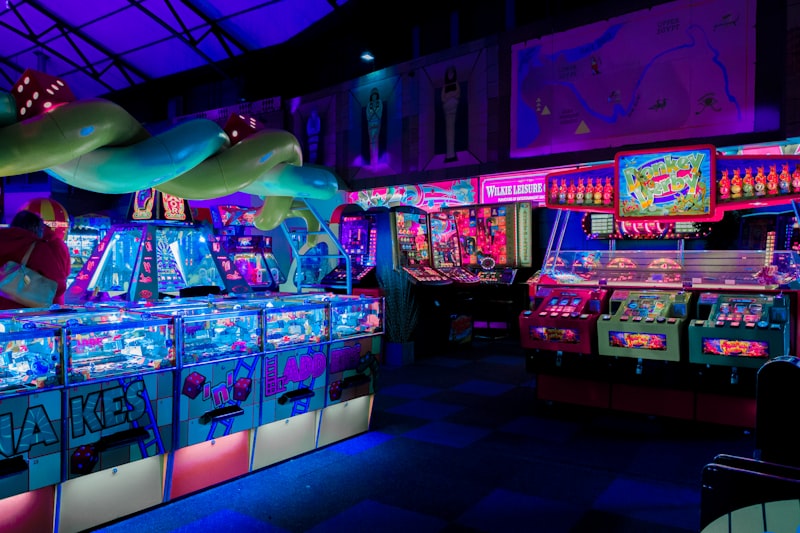Realistic Traffic Modes: Tips For Improving the Traffic Experience

Are you tired of getting stuck in traffic jams day after day? Do you dream of a smoother and more efficient traffic experience? Well, you’re in luck! In this article, we will explore some realistic traffic modes and provide you with valuable tips on how to improve your overall traffic experience. So fasten your seatbelts and let’s hit the road!
-
Carpooling: Sharing is caring, especially when it comes to traffic. Consider carpooling with your colleagues or neighbors who have similar commuting routes. By sharing rides, you can significantly reduce the number of vehicles on the road, thereby easing congestion and saving time.
-
Public Transportation: Embrace the power of public transportation! Buses, trains, and trams offer an excellent alternative to driving alone. Not only does it reduce traffic, but it also helps lower pollution levels and stress. Plus, you can use your travel time to read a book, catch up on emails, or simply relax.
-
Cycling and Walking: If you live in a bike-friendly city or have short distances to cover, why not consider cycling or walking? These modes of transportation are not only eco-friendly but also great for your health. You’ll be amazed at how enjoyable and refreshing your commute can be without the constant honking and traffic snarls.
-
Flexible Work Hours: Are you bound by rigid work hours? Talk to your employer about flexible scheduling options. By staggering work hours, you can avoid peak traffic times and enjoy a smoother journey. Imagine cruising down the road with fewer cars around and less stress weighing you down.
-
Navigation Apps: In the age of smartphones, navigation apps have become our trusty companions on the road. Utilize these apps to plan your route in advance, avoid congested areas, and discover alternate paths. They can provide real-time updates on traffic conditions, helping you make smarter decisions and reach your destination faster.
Remember, improving the traffic experience requires collective effort. Practice patience and courtesy on the road, follow traffic rules, and be mindful of other drivers and pedestrians. Together, we can create a more realistic and enjoyable traffic environment for everyone.
So, the next time you find yourself frustrated in gridlock, think about these realistic traffic modes and tips. By adopting alternative transportation methods, being flexible, and utilizing technology, you can transform your daily commute into a smoother, more pleasant journey. Let’s make our roads a better place, one traffic mode at a time!
Revolutionizing the Commute: Unveiling the Top 10 Realistic Traffic Modes to Enhance your Journey

Introduction:
Are you tired of the daily commute grind, stuck in traffic with your patience wearing thin? Well, it’s time to revolutionize your journey! Say goodbye to the monotonous commute and explore a world of exciting transportation options. In this article, we will unveil the top 10 realistic traffic modes that can enhance your commute and make it an experience to look forward to.
-
Electric Scooters: Zip through the streets effortlessly on an electric scooter, combining convenience and eco-friendliness. These sleek machines are perfect for short distances and can save you from the frustration of traffic congestion.
-
Bicycle Sharing: Embrace a healthy and sustainable commute by hopping on a bicycle. With the rise of bike-sharing programs in cities around the world, you can easily grab a bike and pedal your way to work while enjoying fresh air and exercise.
-
Ride-Sharing Services: Join the ridesharing revolution and leave the driving to someone else. Services like Uber and Lyft offer convenient and affordable options for commuting, allowing you to relax, catch up on emails, or even take a power nap while en route.
-
Carpooling: Share the ride and share the costs with fellow commuters. Carpooling not only reduces traffic congestion but also fosters a sense of community by connecting people who travel similar routes. Plus, splitting fuel expenses can help you save money.
-
Public Transportation: The backbone of urban mobility, public transportation systems provide efficient and reliable ways to get around. Buses, trains, and trams offer a stress-free option for your daily commute, giving you time to read, listen to music, or simply unwind.
-
E-Bikes: Experience the best of both worlds with an electric bike. With just a little pedal power and the assistance of an electric motor, you can effortlessly navigate steep hills and longer distances without breaking a sweat.
-
Motorized Skateboards: For the adventurous souls, motorized skateboards add an element of thrill to your commute. These compact and portable boards let you carve through the streets with ease, making your journey both exciting and efficient.
-
Telecommuting: Why not skip the commute altogether? Telecommuting allows you to work remotely from the comfort of your home or a coworking space. Embrace flexible schedules and avoid the stress of traffic entirely.
-
Electric Cars: Embrace sustainability and reduce your carbon footprint by opting for an electric car. With advances in technology, electric vehicles have become more accessible, offering a greener and quieter ride for your daily commute.
-
Walking: Sometimes the simplest solution is right under our feet. Walking not only keeps you active, but it also allows you to explore your surroundings at a leisurely pace. If your workplace is nearby, consider walking as a refreshing alternative.

Conclusion:
There you have it — the top 10 realistic traffic modes that can revolutionize your commute and transform it into an enjoyable experience. Whether you choose to hop on an electric scooter, share a ride with others, or embrace the simplicity of walking, these options offer alternatives to traditional commuting that are both practical and exciting. So, bid farewell to the frustrations of traffic and embark on a new journey towards a more convenient and fulfilling daily commute.
Mastering the Traffic Game: Expert Tips for an Enhanced and Stress-Free Travel Experience
Are you tired of the hassle and stress that often come with traveling? Do you dream of mastering the traffic game and enjoying a seamless and stress-free travel experience? Well, you’re in luck! In this article, we will share expert tips to help you navigate the chaos and make your journey a breeze. So fasten your seatbelt and get ready for a smoother ride!
First and foremost, plan ahead. One of the key secrets to a stress-free travel experience is proper preparation. Research your destination, check the weather forecast, and familiarize yourself with local customs. Make a list of essentials like travel documents, medications, and important contact numbers. By taking care of these details in advance, you can avoid last-minute panics and enjoy a more relaxed trip.
Next, consider your transportation options. Depending on your destination and preferences, you might choose to fly, drive, or take public transportation. Each mode of transport has its pros and cons, so weigh them carefully. If you decide to drive, plan your route in advance and use navigation apps to avoid traffic jams. If flying, book your tickets early, arrive at the airport with plenty of time to spare, and pack your carry-on wisely.

When it comes to packing, less is more. Be selective and pack only what you truly need. Consider the weather conditions and activities planned for your trip. Remember, lugging around heavy suitcases can be exhausting and stressful. Opt for versatile clothing pieces that can be mixed and matched, and don’t forget to leave some room for souvenirs!
Another tip is to embrace technology. Nowadays, there are numerous travel apps and websites that can make your life easier. From booking accommodations to finding the best local restaurants, these digital tools can save you time and minimize headaches. Additionally, stay connected with loved ones by sharing your itinerary and using messaging apps to keep in touch.
Lastly, maintain a positive mindset. Travel hiccups are bound to happen, but how you handle them can make all the difference. Instead of letting delays or inconveniences ruin your mood, try to see them as part of the adventure. Take deep breaths, stay flexible, and embrace the unexpected.
Mastering the traffic game is all about being prepared, adaptable, and maintaining a positive attitude. By following these expert tips, you’ll be well on your way to an enhanced and stress-free travel experience. Bon voyage!
From Hyperloops to Flying Taxis: Exploring Futuristic Traffic Innovations That Could Transform Our Roads

Are you tired of sitting in traffic jams, wasting precious hours of your life? Well, the future of transportation might hold some exciting innovations that could revolutionize our roads and make commuting a breeze. From hyperloops to flying taxis, let’s explore these futuristic traffic solutions that promise to transform the way we travel.
Imagine stepping into a sleek capsule and being whisked away at high speeds through a vacuum-sealed tube. That’s the concept behind hyperloops, a proposed mode of transport that could reach speeds close to the sound barrier. Using magnetic levitation and low air pressure, hyperloop pods can glide effortlessly, reducing friction and allowing for ultra-fast travel. This technology holds the potential to connect cities and even countries, drastically cutting down travel times and opening up new possibilities for work and leisure.
But if zooming through tubes isn’t your idea of a thrilling commute, how about taking to the skies in a flying taxi? That’s right, companies like Uber and Airbus are actively developing electric vertical takeoff and landing (eVTOL) aircraft that can transport passengers autonomously. These compact air taxis would provide a direct point-to-point service, bypassing congested roads and delivering a whole new level of convenience. With advances in battery technology and autonomous flight systems, we might soon find ourselves hailing flying taxis with a simple tap on our smartphones.

Of course, these innovative concepts come with their fair share of challenges. Building hyperloop networks or establishing a safe and efficient air traffic management system for flying taxis is no small feat. Regulatory hurdles, infrastructure requirements, and public acceptance are just a few of the obstacles that need to be overcome. However, with the rapid pace of technological advancement and growing interest from both public and private sectors, these futuristic traffic solutions may become a reality sooner than we think.
The future of transportation holds tremendous potential to transform our roads. Hyperloops and flying taxis are just two examples of the groundbreaking innovations that could revolutionize the way we commute. Whether it’s traveling at hypersonic speeds through vacuum-sealed tubes or soaring above traffic in autonomous air taxis, these futuristic concepts are indeed awe-inspiring. So, fasten your seatbelts and prepare for a future where commuting becomes an exhilarating experience. The roads of tomorrow might just be closer than we realize.
The Future of Traffic: How Autonomous Vehicles are Set to Alter the Way We Travel
Imagine a world where you can sit back, relax, and let your car do the driving. Sounds like a scene from a sci-fi movie, right? Well, the future is closer than you think. Autonomous vehicles, also known as self-driving cars, are poised to revolutionize the way we travel. In this article, we’ll explore how these cutting-edge vehicles are set to transform the future of traffic.
Autonomous vehicles rely on advanced technologies such as artificial intelligence, sensors, and GPS to navigate the roads without human intervention. This technology has the potential to significantly reduce traffic congestion and improve overall road safety. With self-driving cars communicating with each other and with traffic infrastructure, they can optimize routes, minimize delays, and avoid accidents caused by human error.
One of the most exciting aspects of autonomous vehicles is their potential to improve transportation accessibility for everyone. People with disabilities or those who are unable to drive due to age or other reasons will gain newfound freedom and independence. Self-driving taxis, for example, could provide a convenient and affordable transportation option for individuals who currently face mobility challenges.
Moreover, the adoption of autonomous vehicles will likely lead to a shift in car ownership models. Instead of owning a car that sits idle for most of the day, people may opt for shared autonomous vehicle services. This would decrease the number of vehicles on the road, alleviate parking issues, and reduce the environmental impact of transportation.
As autonomous vehicles become more prevalent, our cities will undergo a transformation. Traditional parking lots could be repurposed into green spaces or used for other community needs. Commute times could be drastically reduced as self-driving cars intelligently navigate through traffic, taking the most efficient routes.
However, the widespread adoption of autonomous vehicles also raises some important questions. How will traffic laws and regulations adapt to accommodate this new technology? What ethical considerations need to be addressed, such as the decision-making process of self-driving cars in potentially life-threatening situations? These are just a few of the challenges that researchers, policymakers, and industry experts are actively working to address.
The future of traffic is set to change dramatically with the rise of autonomous vehicles. These cutting-edge machines have the potential to revolutionize transportation, making it safer, more accessible, and more efficient. While there are still obstacles to overcome, the advancements in self-driving technology bring us one step closer to a world where we can enjoy a seamless and effortless travel experience.




